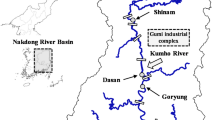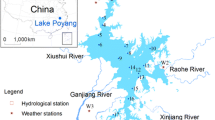Abstract
Long-term time-series data sets of two shallow Dutch lakes, Lake Veluwemeer and Lake Wolderwijd were subjected to ordination and clustering by means of non-supervised artificial neural networks (ANN). Splitting of the data sets into sub-series corresponding with three different management periods have allowed a comparative analysis of both the short-term seasonal and long-term phytoplankton dynamics in relation to the restoration measures. The lakes were considered as hyper-eutrophic and have been managed both with bottom-up and top-down management approaches. Results of the study have demonstrated that non-supervised ANN allow to elucidate causal relationships of complex ecological processes (1) within the specific genus, Oscillatoria and Scenedesmus and (2) the combination of external nutrient control and in-lake food web manipulation of the two lakes achieved to control eutrophication.
Similar content being viewed by others
References
Benndorf, J.: 1995, ‘Possibilities and Limits of Controlling Eutrophication by Biomanipulation, Int. Revue ges.’ Hydrobiol 80(4), 519–534.
Chon, T-S., Young, S.P., Kyong, H.M., and Eui, Y.C.: 1996, ‘Patternizing Communities by Using an Artificial Neural Network,’ Ecological Modelling 90, 69–78.
Hosper, H.: 1997, ‘Clearing Lakes,’ PhD Thesis, Wageningen University, The Netherlands.
Jeong, K.-S. and Joo, G.-J.: ‘Modelling the Succession of Blue-green Algae Species in a Flow Regulated River (the Lower Nakdong River, S.Korea) by Means of a Self-Organizing Map (SOM),’ Ecological Modelling, in press.
Jeppesen, E., Jensen, J.P., Sondergaard, M., Lauridsen, T.L., Pedersen, L.J., and Jensen, L.: 1997, ‘Top-down Control in Freshwater Lakes with Special Emphasis on the Role of Fish, Submerged Macrophytes and Water Depth,’ Hydrobiologia 342/343, 151–164.
Kohonen, T.: 1989, Self-Organization and Associative Memory, Springer-Verlag, Berlin.
Kohonen, T. (ed.): 1995, Self-Organizing Maps, Vol 30, Springer-Verlag, Heidelberg.
Paerl, H.W.: 1988, ‘Nuisance Phytoplankton Blooms in Coastal, Estuarine, and Inland Waters,’ Limnol. Ocenogr. 33, 823–847.
Portielje, R. and Rijsdijk, R.E.: 2003, ‘Stochastic Modelling of Nutrient Loading and Lake Ecosystem Response in Relation to Submerged Macrophytes and Benthivorous Fish,’ Freshwater Biology 48, 741–755.
Recknagel, F., Kim, B., and Welk, A.: 2004, ‘Unravelling and Prediction of of Ecosystem Behaviours of Lake Soyang (South Korea) in Response to Changed Climate and Management by Means of Artificial Neural Networks,’ in Congress of the International Association of Theoretical and Applied Limnology (SIL), Lahti, Finland.
Recknagel, F., Talib, A., and van der Molen, D.T.: 2006, ‘Phytoplankton Community Dynamics of Two Adjacent Dutch Lakes in Response to Seasons and Eutrophication Control Unravelled by Non-supervised Artificial Neural Networks,’ Ecological Informatics 1, 277–285.
Reeders, H.H., Boers, P.C., van der Molen, D.T., and Helmerhorst, T.H.: 1998, ‘Cyanobacterial Dominance in the Lakes Veluwemeer and Wolderwijd, The Netherlands,’ Water Science and Technology 37, 85–92.
Reynolds, C.S. (ed.): 1984, The Ecology of Freshwater Phytoplankton, Cambridge University Press.
Shapiro, J.: 1990, ‘Current Beliefs Regarding Dominance by Blue-greens: The Case for the Importance of CO2 and pH,’ Verh. Internat. Verein. Limnol 24, 38–54.
van der Molen, D.T.: 1999, ‘The Role of Eutrophication Models in Water Management,’ PhD Thesis, Wageningen University, The Netherlands.
van der Molen, D.T., Los, F.J., van Ballegooijen, L.J., and van der Vat, M.P.: 1994, ‘Mathematical Modelling as a Tool for Management in Eutrophication Control of Shallow Lakes,’ Hydrobiologia 275/276, 479–492.
van Tongeren, O.F.R., van Liere, L., Gulati, R.D., Postema, G., and Bosewinkel, P.J.: 1992, ‘Multivariate Analysis of the Plankton Communities in the Loosdrecht Lakes: Relationship with Chemical and Physical Environment,’ Hydrobiologia 233, 105–117.
Varis, O.: 1991, ‘A Canonical Approach to Diagnostic and Predictive Modelling of Phytoplankton Communities,’ Arch.Hydrobiologia 122, 147–166.
Varis, O., Sirvia, H., and Kettunen, J.: 1989, ‘Multivariate Analysis of Lake Phytoplankton and Environmental Factors,’ Arch. Hydrobiol. 117, 163–175.
Vesanto, J.: 1999, ‘SOM-Based Data Visualization Methods,’ Intelligent Data Analysis 3, 111–126.
Walsby, A.E.: 1992, ‘The Control of Gas-vacoulate Cyanobacteria,’ in D.W. Sutcliffe and J.G. Jones (eds.), Eutrophication: Research and Application to Water Supply, Freshwater Biological Association, London, p. 217.
Author information
Authors and Affiliations
Corresponding author
Rights and permissions
About this article
Cite this article
Talib, A., Recknagel, F. & van der Molen, D. Patternising phytoplankton dynamics of two shallow lakes in response to restoration measures by applying non-supervised artificial neural networks. Environmentalist 27, 195–205 (2007). https://doi.org/10.1007/s10669-007-9023-x
Published:
Issue Date:
DOI: https://doi.org/10.1007/s10669-007-9023-x




